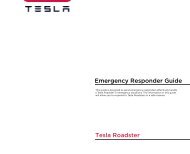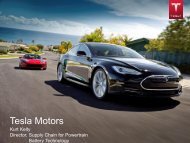Create successful ePaper yourself
Turn your PDF publications into a flip-book with our unique Google optimized e-Paper software.
University of Oregon Investment Group<br />
April 18, 2013<br />
In today’s market, auto manufactures offer hundreds of vehicles models that<br />
using alternative fuels and other advantaged technologies. These light-duty<br />
vehicles exist for the purpose of helping drivers and fleets reduce petroleum use,<br />
cut emissions, and save money on fuel costs. In 2013, many vehicles set to<br />
arrive including Compressed Natural Gas Vehicles, Propane Vehicles, Allelectric<br />
Vehicles, Plug-In Hybrid Electric Vehicles, Hybrid Electric Vehicles,<br />
Ethanol Flex-Fuel Vehicles and Biodiesel Vehicles. Next, we will briefly<br />
discuss the advantages and disadvantages of each group of vehicles.<br />
Compressed Natural Gas Vehicles<br />
The same fuel used for cooking and heating in many homes powers compressed<br />
Natural Gas (CNG) Vehicles. In the U.S., we have plenty natural gas supplies<br />
and we are currently developing more ways to generate natural gas. For<br />
example, some producers capture renewable natural gas from landfills, sewage<br />
treatment facilities, or agricultural waste. Thus, CNG costs less than gasoline in<br />
most cases and the resulting savings can offset the higher purchase price of<br />
CNG Vehicles.<br />
Honda Civic Natural Gas<br />
In 2013, three dedicated CNG Vehicles are available, including Honda Civic<br />
Natural Gas, the natural gas General <strong>Motors</strong> Chevrolet Express/ GMC Savana,<br />
and the Vehicle Production Group (VPG) MV-1. Two CNG-gasoline hybrid<br />
vehicles, including GMC Sierra 2500 HD and the Ram 2500 CNG, that can<br />
operate on natural gas and then switch to gasoline operation when the CNG<br />
cylinders are empty. CNG Vehicles drivers need to consider fueling<br />
infrastructure. Up until February 2013, there were 500 publicly accessible CNG<br />
fueling stations across the country., while there were 121446 (June 2012 data)<br />
gasoline stations in the U.S.<br />
Propane Vehicles<br />
Ford Super Duty F-250<br />
Propane, also known as liquefied petroleum gas, which is a clean-burning<br />
gaseous fuel that’s been used in transportation for decades. Propane is the most<br />
commonly used alternative motor fuel in the world and it is nontoxic, safe to<br />
handle and presents no threat to soil, groundwater, or surface water when spilled<br />
or leaked. There were 2500 stations that serve propane throughout the country.<br />
Almost all the Propane Vehicles are heavy-duty pickups or vans.<br />
Plug-In Hybrid Electric Vehicles<br />
Plug-In Hybrid Electric Vehicles (PHEVs) use batteries to power an electric<br />
motor and use another fuel to power an internal combustion engine. Normally,<br />
the other fuel can be gasoline or diesel. The batteries can be charged from an<br />
off-board electrical power source, through regenerative braking, or by the<br />
internal combustion engine. PHEVS can be fueled solely with gasoline, so they<br />
don’t have to be plugged in before driving. However, they will not achieve<br />
maximum fuel economy without charging.<br />
Toyota Prius Plug-In Hybrid<br />
UOIG 5







